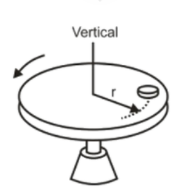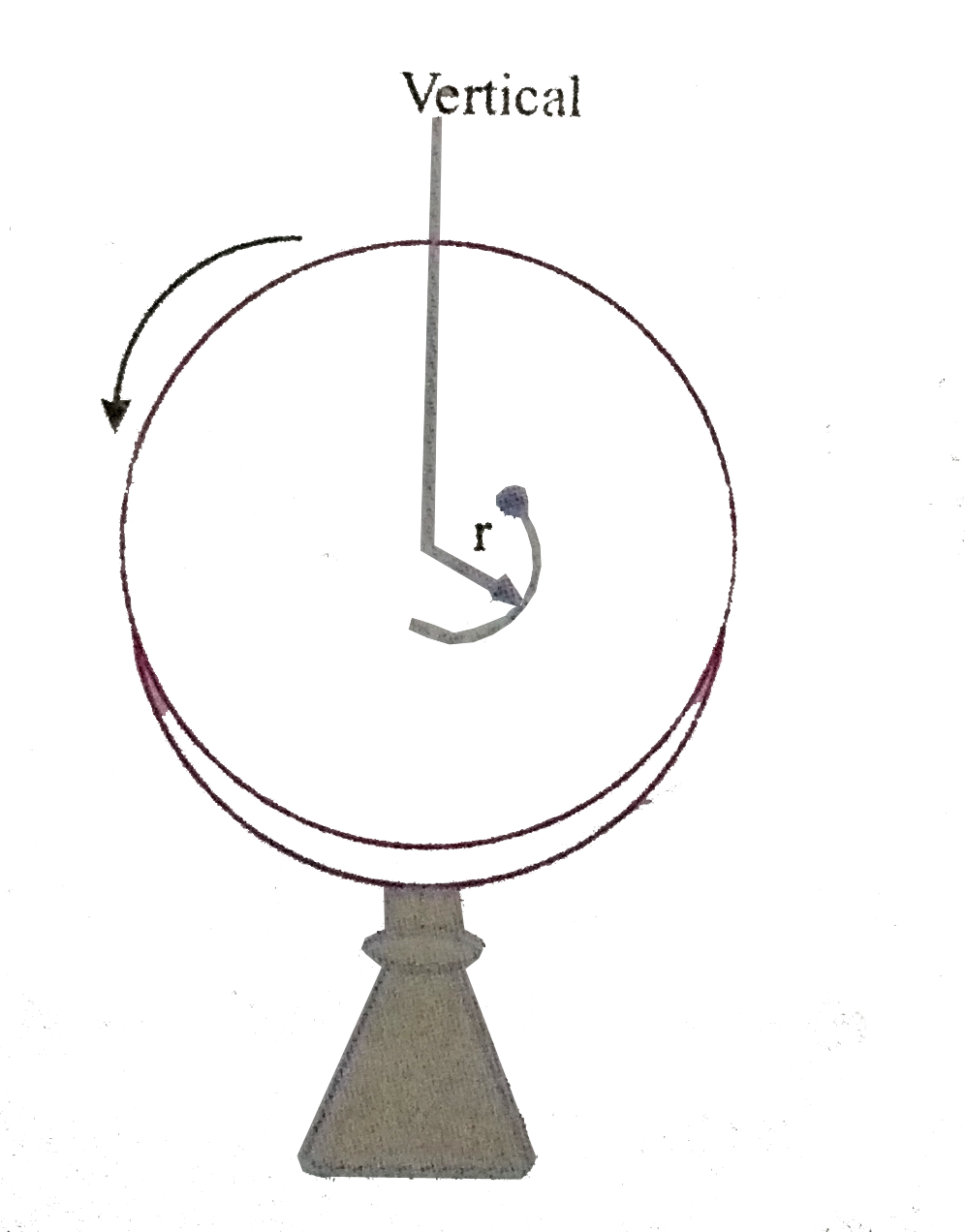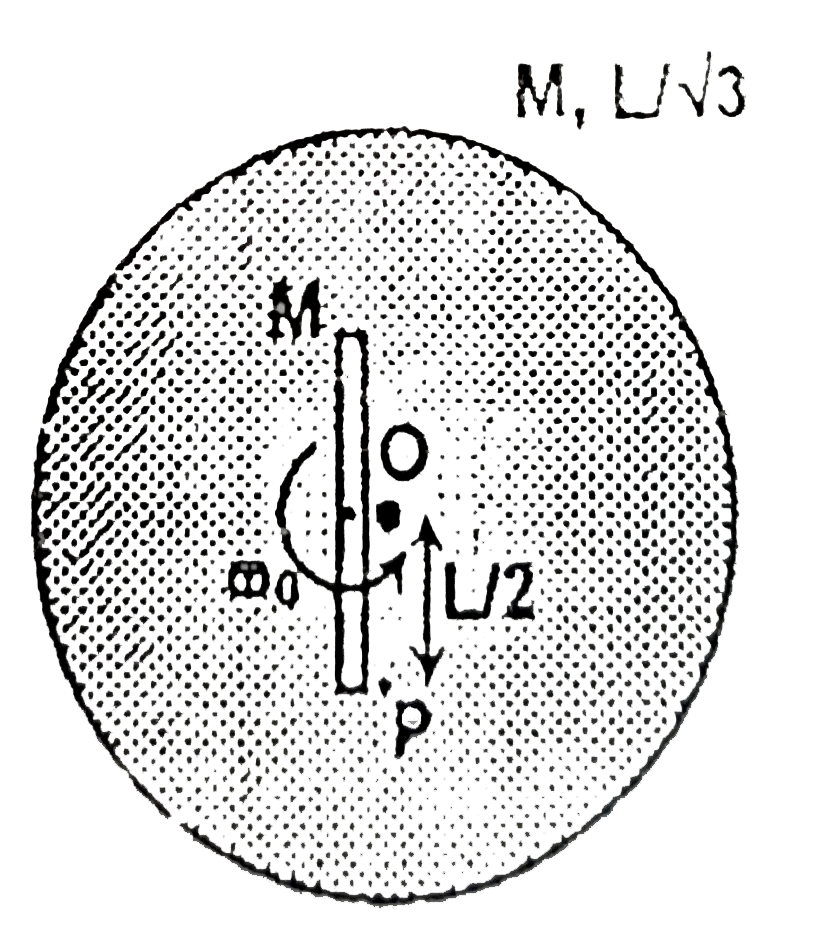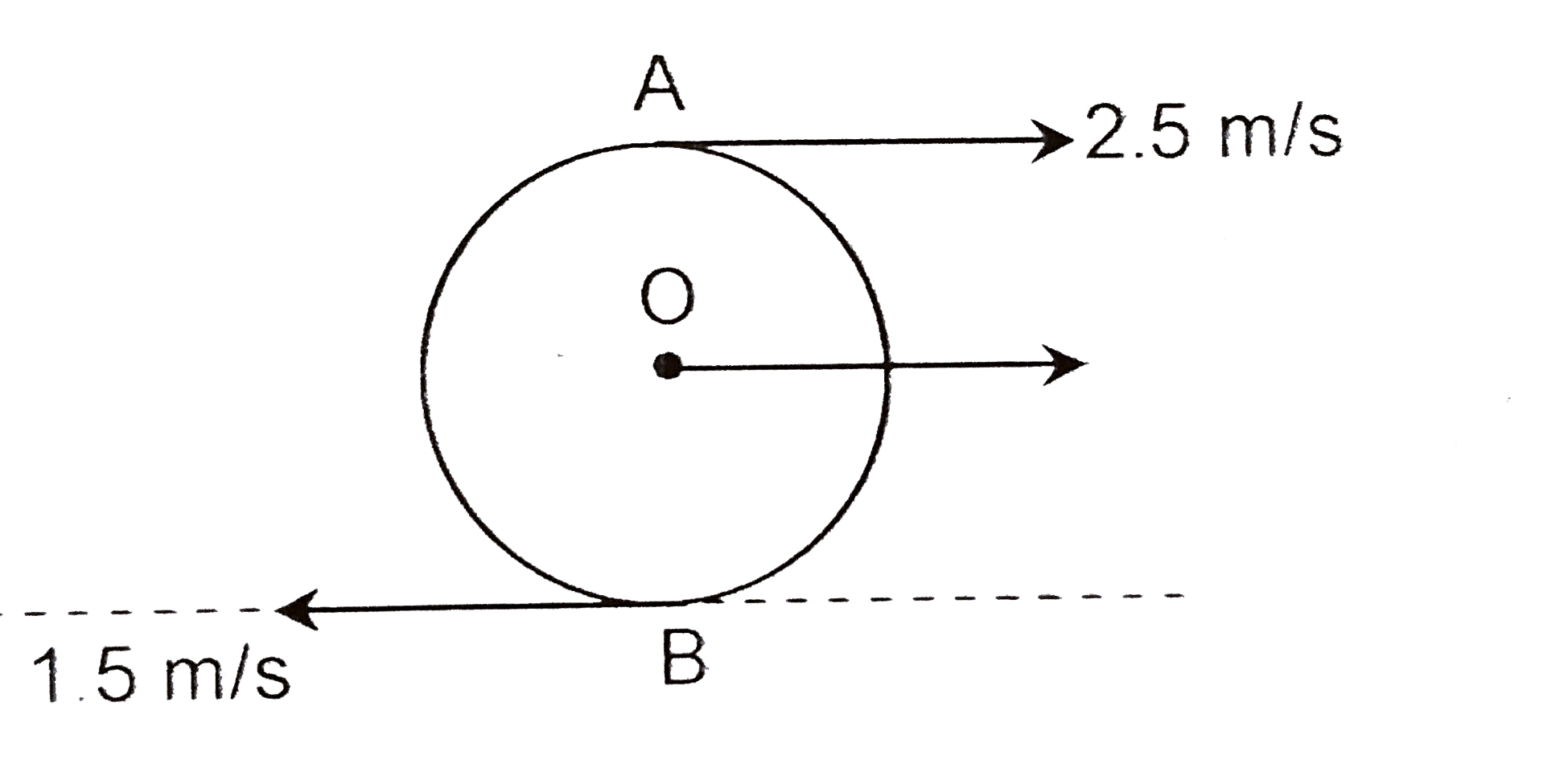A coin is placed on the horizontal surface of a rotation disc. The distance of the coin from the axis is 1 m and coefficient of friction is 0.5. If the disc starts from rest and is given an angular acceleration 1√2 rad /sec2, the number of revolutions through which the disc turns before the coin slips is
4π
74π
5√24π
34π
The correct Answer is:B
To solve the problem step by step, we will follow the reasoning outlined in the video transcript and derive the necessary equations.
Step 1: Identify the forces acting on the coin
The coin experiences two main forces:
- The gravitational force (weight) acting downwards: Fg=mg
- The normal force N acting upwards.
Since the coin is on a horizontal surface, these forces balance each other:
N=mg
Step 2: Determine the centripetal force required to keep the coin moving in a circle
The required centripetal force Fc for the coin to stay on the disc is provided by the frictional force. The centripetal force can be expressed as:
Fc=mω2R
where ω is the angular velocity and R is the radius (1 m in this case).
Step 3: Relate the frictional force to the centripetal force
The maximum static frictional force Ff that can act on the coin is given by:
Ff=μN=μmg
Substituting N=mg:
Ff=μmg
Step 4: Set the frictional force equal to the centripetal force
For the coin to not slip, the frictional force must be equal to the required centripetal force:
μmg=mω2R
Cancelling m from both sides (assuming m≠0):
μg=ω2R
Step 5: Substitute the known values
Given:
- μ=0.5
- g=10m/s2
- R=1m
Substituting these values into the equation:
0.5×10=ω2×1
5=ω2
Thus, we find:
ω=√5rad/s
Step 6: Use angular acceleration to find the time until slipping occurs
The disc starts from rest and has an angular acceleration α=1√2rad/s2. We can use the kinematic equation for angular motion:
ω2f=ω2i+2αθ
Where:
- ωf=√5
- ωi=0
- α=1√2
- θ is the angle in radians.
Substituting the known values:
5=0+2(1√2)θ
5=2√2θ
5=√2θ
Thus, solving for θ:
θ=5√2radians
Step 7: Convert the angle from radians to revolutions
To find the number of revolutions n:
n=θ2π=5/√22π=52π√2
Final Answer
The number of revolutions through which the disc turns before the coin slips is:
n=52π√2
The coin experiences two main forces:
- The gravitational force (weight) acting downwards: Fg=mg
- The normal force N acting upwards.
N=mg
The required centripetal force Fc for the coin to stay on the disc is provided by the frictional force. The centripetal force can be expressed as:
Fc=mω2R
where ω is the angular velocity and R is the radius (1 m in this case).
The maximum static frictional force Ff that can act on the coin is given by:
Ff=μN=μmg
Substituting N=mg:
Ff=μmg
For the coin to not slip, the frictional force must be equal to the required centripetal force:
μmg=mω2R
Cancelling m from both sides (assuming m≠0):
μg=ω2R
Given:
- μ=0.5
- g=10m/s2
- R=1m
0.5×10=ω2×1
5=ω2
Thus, we find:
ω=√5rad/s
The disc starts from rest and has an angular acceleration α=1√2rad/s2. We can use the kinematic equation for angular motion:
ω2f=ω2i+2αθ
Where:
- ωf=√5
- ωi=0
- α=1√2
- θ is the angle in radians.
5=0+2(1√2)θ
5=2√2θ
5=√2θ
Thus, solving for θ:
θ=5√2radians
To find the number of revolutions n:
n=θ2π=5/√22π=52π√2
The number of revolutions through which the disc turns before the coin slips is:
n=52π√2
Topper's Solved these Questions
- RACEBOOK - ALLENCHAPTER - RACEEXERCISE - Basic Maths (COLLISION AND CENTRE OF MASS )
12 Videos
- RACEBOOK - ALLENCHAPTER - RACEEXERCISE - Basic Maths (ROTATIONAL MOTION)
72 Videos
- RACEBOOK - ALLENCHAPTER - RACEEXERCISE - Basic Maths (WORK POWER & ENERGY)
34 Videos
- NEWTONS LAWS OF MOTIONBOOK - ALLENCHAPTER - NEWTONS LAWS OF MOTIONEXERCISE - EXERCISE-III
28 Videos
- SIMPLE HARMONIC MOTIONBOOK - ALLENCHAPTER - SIMPLE HARMONIC MOTIONEXERCISE - Example
1 Videos
Similar Questions
A small coin of mass 40 g is placed on the horizontal surface of a rotating disc. The disc starts from rest and is given a constant angular acceleration α=2 rad s−2. The coefficient of static friction between the coin and the disc is μs=3/4 and the coefficient of kinetic friction is μk=0.5. The coin is placed at a distance r=1m from the centre of the disc. The magnitude of the resultant force on the coin exerted by the disc just before it starts slipping on the disc is?

View SolutionA small coin of mass 80g is placed on the horizontal surface of a rotating disc. The disc starts from rest and is given a constant angular acceleration α=2rad/s2. The coefficient of static friction between the coin and the disc is μs=3/4 and cofficient of kinetic friction is μk=0.5. The coin is placed at a distance r=1m from the centre of the disc. The magnitude of the resultant force on the coin exerted by the disc just before it starts slipping on the disc is

View SolutionA small coin of mass 80g is placed on the horizontal surface of a rotating disc. The disc starts from rest and is given a constant angular acceleration α=2rad/s2. The coefficient of static friction between the coin and the disc is μs=3/4 and cofficient of kinetic friction is μk=0.5. The coin is placed at a distance r=1m from the centre of the disc. The magnitude of the resultant force on the coin exerted by the disc just before it starts slipping on the disc is

View SolutionIf a disc starting from rest acquires an angular velocity of 240rev min−1 in 10 s, then its angular acceleration will be
View SolutionA semicircle disc of mass M and radius R is held on a rough horizontal surface as shown in figure. The centre of mass C of the disc is at a distance of 4R3π from the point O. Now the disc is released from this position so that it starts rolling without slipping. Find

(a) The angular acceleration of the disc at the moment it is relased from the given position.
(b) The minimum co-efficient of fricition between the disc and ground so that it can roll without slipping.
View SolutionA smooth disc of mass M and radius L√3 is placed at rest horizontally on a smooth horizontal surface. A massless pin is fixed at point P at a distance L/2 from centre O of the disc as shown in the figure. Now a thin uniform rod of mass M and length L is placed horizontally on the surface of the disc parallel to the line OP such that its mid point and centre O of the disc just coincide as shown in figure. Now rod has given angular velocity ω0=24rad/sec in counter clockwise direction as shown. As a result, the end of the rod strikes the pin P and stricks to it rigidly. Calculate the angular velocity of disc just after collision.

View SolutionA disc having radius r=2m is placed on smooth horizontal surface. Velocity of point A and B is given as shown in fig. Distance between point O and axis of rotation at the particular instant is

View SolutionA point on the rim of a disc starts circular motion from rest and after time t, it gains an angular acceleration given by α=3t−t2. Calculate the angular velocity after 2 s.
View SolutionA disc is given an initial angular velocity ω0 and placed on a rough horizontal surface as shown Fig. The quantities which will not depend on the coefficient of friction is/are

View SolutionA disc of radius 0.2m is rolling with slipping on a flat horizontal surface, as shown in Fig. The instantaneous centre of rotation is (the lowest contact point is O and centre of disc is C)

View Solution
